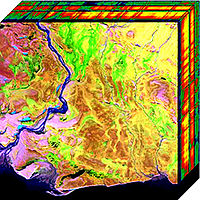
Photo from wikipedia
Hyperspectral target detection is a crucial application that encompasses military, environmental, and civil needs. Target detection algorithms that have prior knowledge often assume a fixed laboratory target spectrum, which can… Click to show full abstract
Hyperspectral target detection is a crucial application that encompasses military, environmental, and civil needs. Target detection algorithms that have prior knowledge often assume a fixed laboratory target spectrum, which can differ significantly from the test image in the scene. This discrepancy can be attributed to various factors such as atmospheric conditions and sensor internal effects, resulting in decreased detection accuracy. To address this challenge, this article introduces a novel method for detecting hyperspectral image (HSI) targets with certain spatial information, referred to as the semantic transferred priori for hyperspectral target detection with spatial–spectral association (SSAD). Considering that the spatial textures of the HSI remain relatively constant compared to the spectral features, we propose to extract a unique and precise target spectrum from each image data via target detection in its spatial domain. Specifically, employing transfer learning, we designed a semantic segmentation network adapted for HSIs to discriminate the spatial areas of targets and then aggregated a customized target spectrum with those spectral pixels localized. With the extracted target spectrum, spectral dimensional target detection is performed subsequently by the constrained energy minimization (CEM) detector. The final detection results are obtained by combining an attention generator module to aggregate target features and deep stacked feature fusion (DSFF) module to hierarchically reduce the false alarm rate. Experiments demonstrate that our proposed method achieves higher detection accuracy and superior visual performance compared to the other benchmark methods.
Journal Title: IEEE Transactions on Geoscience and Remote Sensing
Year Published: 2023
Link to full text (if available)
Share on Social Media: Sign Up to like & get
recommendations!